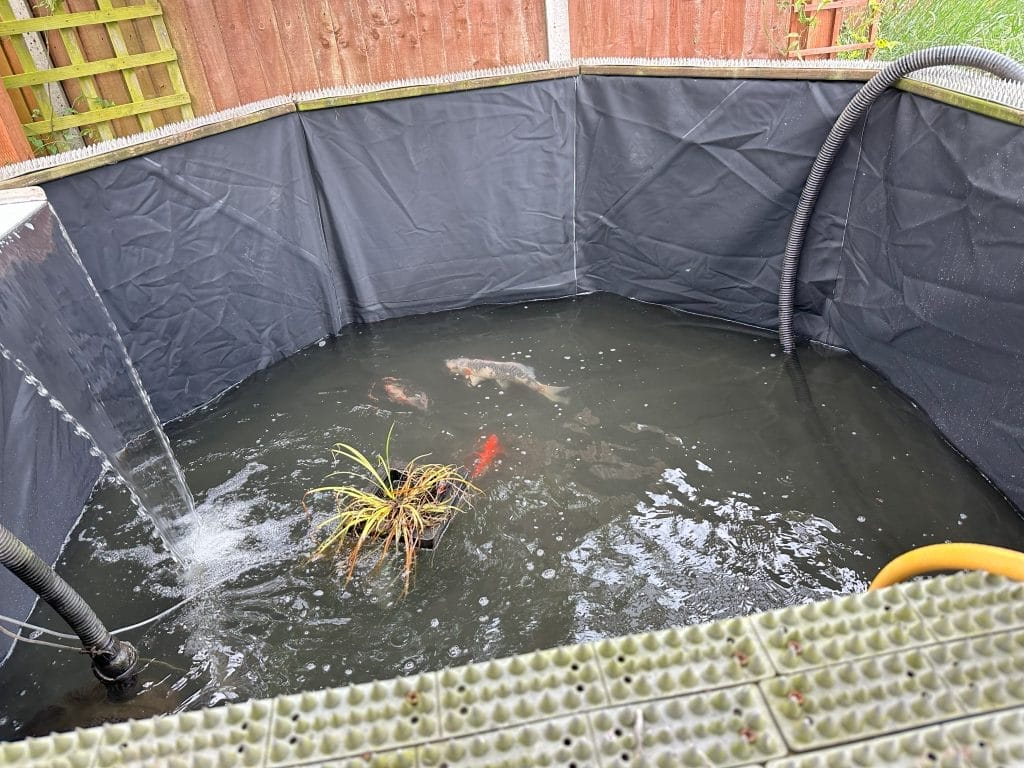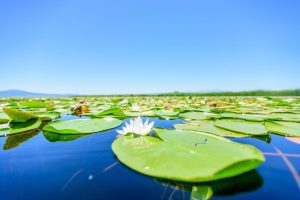
Box Welded Pond Liners: The Ultimate Solution for Durable Water Containment
Box welded pond liners are an essential component for any successful pond build.
They offer a reliable solution for water gardening projects, ensuring that ponds are both beautiful and functional.
Made from high-quality materials, such as Butyl rubber and EPDM, these liners are designed to fit various shapes and sizes, providing long-lasting performance.

When selecting a box welded pond liner, several factors come into play.
Understanding the materials used and the manufacturing process can help pond owners make informed choices.
Additionally, proper installation and maintenance are crucial for maximising the liner’s durability and effectiveness throughout the years.
Investing in box welded pond liners not only enhances the aesthetics of a garden but also supports the health of aquatic life.
With the right liner, water gardeners can create a thriving ecosystem that adds value to their properties while enjoying the tranquillity of nature.
Key Takeaways
- Box welded pond liners provide durability and flexibility for various pond designs.
- High-quality materials enhance performance and longevity in water gardening.
- Proper installation and maintenance are vital for long-term success.
Benefits of Using Box Welded Pond Liners
Box welded pond liners offer several advantages that can enhance the quality and longevity of any water feature.
With their unique design and construction, these liners provide a reliable solution for maintaining a healthy pond ecosystem and ensuring a visually appealing installation.
Seamless Construction
One of the primary benefits of box welded pond liners is their seamless construction.
These liners are crafted from high-quality materials that are fully welded at the corners.
This feature eliminates the need for site joins, which can be weak points in traditional liners.
Without seams, the risk of leaks is significantly reduced, providing better protection for the pond’s water.
A relaxed fit ensures that the liner will adapt to the shape of the pond, further enhancing its effectiveness in holding water securely.
Enhanced Durability
Box welded pond liners are designed for durability.
Made from robust materials like Butyl rubber or EPDM, these liners can withstand harsh weather conditions and temperature fluctuations.
Their strength means they resist punctures and tears better than typical flat liners.
Additionally, the fully welded corners contribute to a long life span.
This durability means less frequent replacements, making it a cost-effective choice for pond owners. It also leads to improved pond water quality, as these liners help prevent contaminants from entering the aquatic environment.
Aesthetic Appeal
A well-fitted box welded pond liner enhances the overall aesthetic of a pond.
Unlike flat sheet liners, which can create unsightly folds and creases, box welded liners provide a smooth, tidy appearance.
The liner’s flange can be hidden under paving or stones, creating a clean edge around the pond.
This design not only looks good but also helps blend the pond into its natural surroundings, making it a striking feature in any landscape.
Materials and Manufacture

The materials and manufacturing processes used for box welded pond liners determine their durability and effectiveness.
Quality components like Butyl rubber are key, and precise fabrication techniques contribute to the final product’s reliability.
Butyl as a Preferred Material
Butyl rubber is favoured for box welded pond liners due to its excellent resilience and flexibility.
It has a standard thickness of 1 mm, which strikes a balance between durability and weight.
This material is highly resistant to UV light, ensuring that it won’t become brittle over time.
Additionally, Butyl rubber is known for its ability to expand and contract with environmental changes, maintaining its integrity under various conditions.
A lifetime guarantee often accompanies these liners, reflecting the confidence manufacturers have in the material’s longevity.
Manufacturing Techniques
Box welded pond liners are created through a process that involves precise cutting and welding.
The panels are cut to specific measurements before being welded together at the seams. This ensures a perfect fit for every installation.
Vulcanisation is a common technique used during manufacturing.
It enhances the rubber’s durability by creating cross-links between the polymer chains. This process helps to improve the material’s strength and resistance to punctures and tears.
Specialised equipment is usually employed to handle the welding. This ensures that the seams are watertight and strong enough to withstand the pressures of a full pond.
Quality Assurance
Quality assurance is vital in the manufacturing of pond liners.
Each liner undergoes rigorous testing for defects and material integrity.
Manufacturers often implement a multi-step inspection process to ensure that every product meets high standards.
The liners are typically checked for thickness and flexibility to confirm that they adhere to specifications.
Additionally, manufacturers may perform water-tightness tests to guarantee performance once installed.
A comprehensive guarantee often covers these products, providing consumers with peace of mind regarding their investment.
Installation Process

The installation of box welded pond liners involves careful preparation and precise fitting.
It is crucial to ensure a smooth and secure installation for longevity and optimal performance.
Preparation and Underlay
Before installing the pond liner, the area needs thorough preparation.
Begin by clearing the pond site of any debris, rocks, and sharp objects that could damage the liner.
Next, consider using an underlay.
This protective layer, usually made from spun-bound polypropylene, acts as a barrier against punctures from roots and rough surfaces. It is particularly useful over uneven concrete or wooden surfaces.
The underlay should be cut to size and laid flat to avoid any irregularities beneath the liner.
Fitting the Liner
Once the underlay is set, the next step is to fit the liner.
A box welded liner should be placed carefully into the prepared pond shape. It is essential to ensure it extends over any ledges or shelves within the pond.
During this stage, check for wrinkles or folds, as these can trap waste and reduce the liner’s lifespan.
Adjust the liner as needed. If anchored correctly, the liner should stay in position without excessive movement.
It is advisable to have an assistant during this phase to help handle the larger, heavier liners, ensuring a smooth installation.
Edging and Finishing
After fitting the liner, attention turns to the edging. This part of the process involves securing the liner to prevent it from shifting.
Soil or gravel can be placed over the edges to hold the liner in place. This helps to provide stability and gives the pond a finished look.
It is essential to allow enough liner to extend beyond the edge for this purpose.
This ensures both functionality and aesthetics in the final appearance of the pond.
Proper edging contributes to the overall strength and durability of the pond structure.
Design Considerations for Box Welded Liners

When designing with box welded pond liners, specific factors play a critical role in achieving a successful installation.
Understanding the shape and measurements of the pond is essential for a precise fit.
Detailed attention to the pond’s geometry and sizing will lead to optimal functionality and aesthetics.
Ponds with Complex Geometries
Box welded liners are ideal for formal shaped ponds, such as rectangular, circular, or ponds with intricate designs.
These liners are prefabricated, meaning they can perfectly match the unique shape of a pond.
When dealing with complex shapes, having accurate measurements is crucial.
Any deviations in size can lead to improper fit, causing potential issues with water retention.
It’s important to provide precise dimensions, including depth, width, and any shelves or angles.
Working with a professional can ensure that the liner adheres tightly to the pond’s design, providing a durable and attractive feature in the garden.
Sizing and Tailoring
Proper sizing and tailoring of the box welded liner are fundamental for effective pond design.
Each liner should be custom-made based on the pond’s specific dimensions.
A well-fitted liner not only looks good but also reduces the risk of folds or creases that could compromise water levels.
Before placing an order, it is advisable to take comprehensive measurements.
This includes assessing the vertical sides of the pond and any variations in depth.
A box welded liner typically requires only a solid base to install, which simplifies the process.
By ensuring accurate sizing, pond owners can enjoy a seamless installation experience and long-lasting results.
Making these careful considerations can enhance both the visual appeal and functionality of the water feature.
Durability Factors

Box welded pond liners are designed to withstand various environmental challenges.
Their durability is influenced by factors like UV stability, mechanical resilience, and chemical resistance, making them suitable for long-term use in diverse settings.
UV and Weather Resistance
Box welded pond liners are particularly valued for their UV stability.
This ensures they do not degrade quickly when exposed to sunlight.
Over time, UV rays can weaken materials, causing cracks and leaks. High-quality butyl rubber used in these liners provides excellent resistance to sun damage.
Additionally, these liners are built to handle weather extremes.
Whether facing harsh winters or scorching summers, they remain flexible and functional.
This makes them ideal for regions with fluctuating temperatures. Their capacity to endure these conditions prevents premature replacement and maintenance issues.
Resilience to Mechanical Damage
Mechanical damage can occur from sharp objects or the weight of surrounding materials.
Box welded pond liners exhibit strong resistance to punctures. This resilience is vital for maintaining the integrity of the pond.
The construction of these liners also adds to their durability.
They are typically thicker than standard liners, meaning they can better absorb impacts.
This strength makes them suitable for areas with heavy foot traffic or where wildlife may disturb the lining. Regular inspection can further enhance their lifespan.
Chemical Resistance and Ecology
Chemical stability is another significant factor in the durability of box welded pond liners. They are designed to be chemically stable, meaning they do not react negatively with substances that may leach into the water.
This includes potential pollutants or additives used in ponds.
Moreover, these liners are non-toxic and plant-friendly, ensuring that they do not harm aquatic life or surrounding plants.
They do not leach harmful substances into the water, making them a safe choice for environmental health.
This combination of features supports a thriving ecosystem within the pond while maintaining the liner’s integrity over time.
Performance under Load
When selecting a box welded pond liner, understanding its performance under different loads is crucial.
This includes how it handles compressive loads and its response to ground movement. These factors can impact the durability and longevity of the liner.
Compressive Loads and Ground Movement
Box welded pond liners are designed to withstand significant compressive loads. This is essential in areas where soil shifts or settles.
The materials used often have high tear strength and tensile strength, ensuring they do not easily rupture under pressure.
Ground movement, whether due to natural settling or external factors, affects liner stability. Proper installation is vital to minimise risks.
Liners with reinforced edges, such as box welded designs, offer extra support against such stresses.
Additionally, using a protective underlay can further enhance the liner’s performance by absorbing shocks and preventing punctures.
Regular maintenance can also improve longevity, ensuring the liner remains effective over time.
Aftercare and Maintenance
Maintaining a Box Welded Pond Liner is essential for its long-term durability and function.
Regular inspections, effective repair techniques, and thoughtful long-term care are crucial for extending the liner’s maximum life expectancy.
Routine Inspections
Routine inspections of the pond liner should occur at least twice a year. This helps to identify any potential issues early.
Look for signs of wear, such as cracks, bulges, or punctures. It is also important to assess the area around the pond for debris that could damage the liner.
He or she should check the water level and ensure there are no leaks.
Observing water clarity is key; cloudy water may indicate problems.
A simple checklist can help to make these inspections thorough and efficient, ensuring nothing is overlooked.
Repair and Patching Techniques
If any damage is found, immediate repair is recommended. Small punctures can often be repaired with a simple patch kit made for pond liners.
These kits typically include adhesive and patches that match the liner material.
When applying a patch, clean the area thoroughly and ensure it’s dry.
For larger holes or extensive damage, replacement sections or professional help may be needed.
Proper repairs can significantly extend the life of the liner, allowing it to last well beyond the average expectancy.
Long-Term Care Tips
Long-term care for a Box Welded Pond Liner involves protecting it from UV damage.
He or she should consider using pond plants to provide shade, as excessive sunlight can degrade the material over time.
Regularly check the water chemistry, avoiding harsh chemicals that can affect the liner.
Water treatments should be pond-safe to prevent damage.
Lastly, keeping the surrounding area clear of sharp rocks and debris will help maintain the integrity of the liner long-term.
Accessories and Additional Elements
When installing a box welded pond liner, various accessories can enhance durability and aesthetics.
Key elements include geotextile protection and both decorative and functional accessories. These elements contribute significantly to the longevity and appearance of the pond.
Geotextile Protection
Geotextile fabric plays a crucial role in pond installations. It serves as a protective layer placed beneath the box welded liner.
This fabric minimizes damage from sharp objects such as rocks or roots that may be present in the soil.
Using geotextile can prolong the life of the pond liner by reducing wear and tear.
It also improves water drainage, which can help prevent water build-up beneath the liner.
This protection is essential, especially in areas with uneven ground or roots that could cause punctures.
Choosing a high-quality geotextile that is both permeable and durable ensures the best results.
It is often recommended to measure the pond area accurately to purchase enough fabric for full coverage.
Decorative and Functional Accessories
Various accessories can enhance both the functionality and aesthetics of a pond.
Items like pond lights, fountains, and pumps are popular. They improve water circulation and create visual appeal, especially at night.
Pond edging materials are also essential. They secure the top of the box welded liner and provide a finished look. Options include stone, brick, or decorative garden edging.
For added safety, consider incorporating a pond net to protect fish from predators. Such nets can also help keep debris out of the pond.
Environmental Considerations
When selecting box welded pond liners, it’s vital to consider their impact on the local ecosystem and the methods used for installation. Awareness of these factors can promote a healthier water garden environment.
Impact on Local Ecosystem
Box welded pond liners can influence the surrounding ecosystem significantly. They help to contain water in koi ponds, allowing for various plant life to flourish.
Well-maintained liners prevent water loss, maintaining optimal conditions for aquatic flora and fauna.
Choosing puncture-resistant materials ensures long-lasting protection, which minimizes the risk of leaks that could negatively affect the ecosystem.
Without proper liners, water loss can result in decreased habitat for local wildlife.
Furthermore, the right liner can support the balance of fish and plant life while keeping the pond healthy for years.
Sustainable Practices
Implementing sustainable practices is essential for responsible pond management.
Selecting eco-friendly materials, like EPDM, can reduce environmental impact during production and use.
This type of liner is durable and has a low carbon footprint, making it suitable for water gardeners focused on sustainability.
Installation methods also play a role. Using natural materials for pond bedding, such as sand and gravel, supports plant life and enhances water filtration.
Regular maintenance, like ensuring proper liner placement, contributes to the liner’s longevity and the overall health of the pond, making it a responsible choice for any koi pond project.
Choosing a Supplier
Selecting the right supplier for box welded pond liners is crucial to ensuring a successful and long-lasting pond installation. Important factors include the reputation of the supplier, the quality of their products, and the level of support they offer.
Criteria for Selection
When choosing a supplier, several criteria should be considered.
The first is experience. Suppliers with a long history in the industry, such as those recognised by water gardening experts, tend to provide reliable products.
Next, check the quality of materials used. Box welded liners should be durable, UV resistant, and chemically stable.
It’s beneficial to request samples or specifications to verify this.
Pricing should also be transparent.
Compare quotes from multiple suppliers and ensure that the prices reflect the quality of the materials. A good supplier will provide a breakdown of costs.
Lastly, look for customer reviews or testimonials. Positive feedback from professional pond builders can provide valuable insight into the supplier’s reliability.
Warranty and Support
A solid warranty is essential when purchasing box welded liners.
Many suppliers offer a lifetime guarantee, which protects the buyer against manufacturing defects.
This warranty reflects the confidence the supplier has in their product.
In addition to warranty terms, consider the level of customer support offered.
Suppliers should provide assistance before, during, and after the purchase.
It’s important they have knowledgeable staff who can advise on installation and maintenance.
Responsive support can save time and resources.
Check if the supplier offers resources like tutorial videos or installation guides.
They should also be accessible for any queries that may arise after the purchase.
Related Posts
- Pond Cleaning & Maintenance Service Berkhamsted
- Pond Maintenance Near Me
- Guide to Frogs and Toads: Spawning Seasons and Care Essentials
- Koi Pond Building
- Pond Cleaning Service Leighton Buzzard
- Pond Netting Autumn Service: Essential Steps for Effective Pond Protection
- Top Reasons to Hire a Pond Expert for Your Garden: Unlocking Professional Insights for Optimal Results
- Garden Pond Cleaning & Maintenance Service: Essential Care for a Thriving Aquatic Environment


